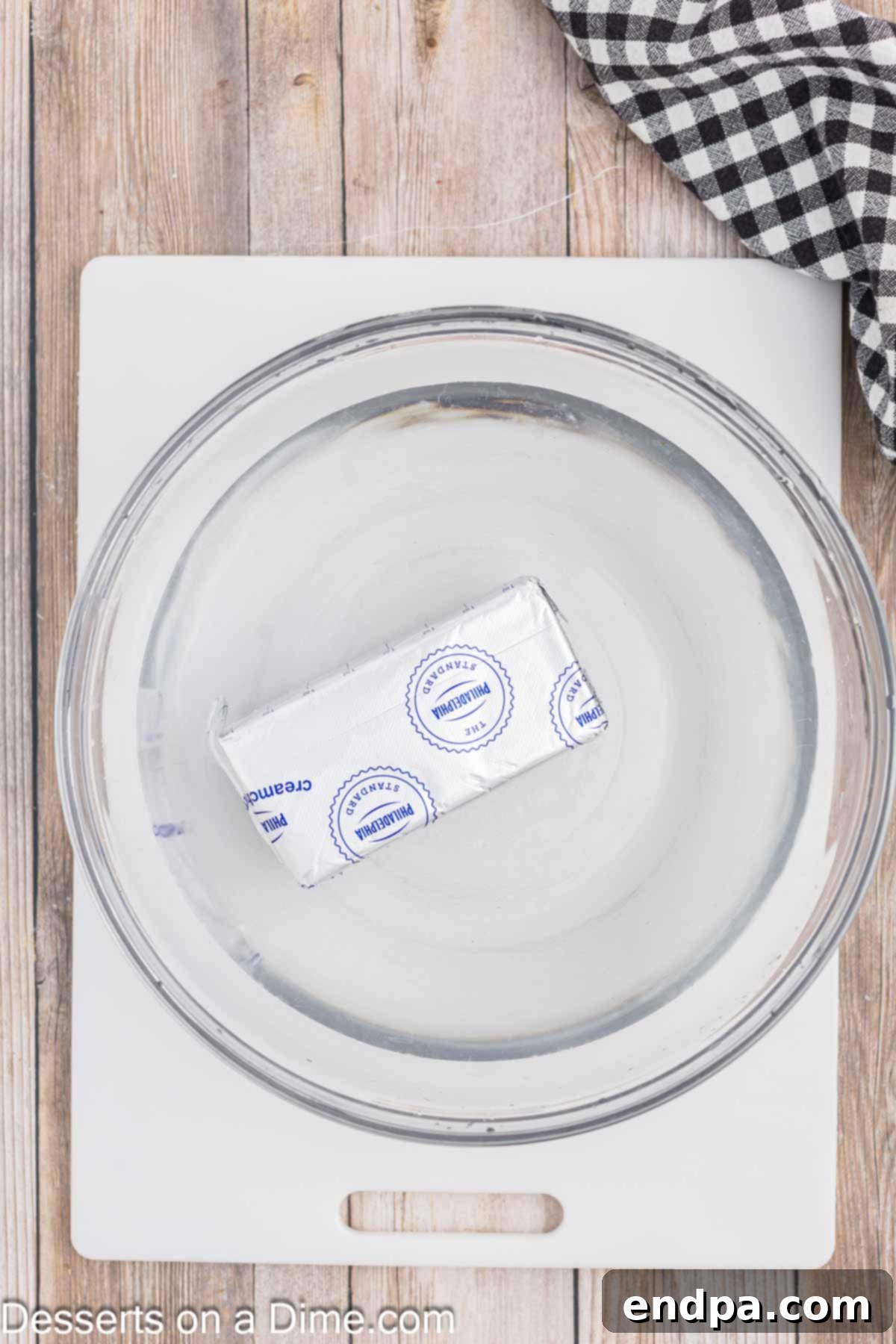Unlock the secret to flawlessly smooth and lump-free desserts by mastering how to soften cream cheese. This essential baking technique ensures your cheesecakes, frostings, and pastries achieve their ultimate creamy perfection. Forget last-minute kitchen panics; we’ll guide you through three simple, reliable methods to bring your cream cheese to ideal room temperature quickly and effectively.

Achieving the perfect consistency for your cream cheese is non-negotiable in baking. When cream cheese is cold and hard, it’s notoriously difficult to blend, often resulting in a lumpy texture and an uneven mixture. Softened cream cheese, on the other hand, whips up beautifully, incorporating smoothly with other ingredients like sugar and butter, yielding a light, airy, and uniformly creamy base for your culinary creations.
Whether your next project is a decadent Philadelphia No-Bake Cheesecake, a fluffy Homemade Cream Cheese Frosting for cupcakes, or delightful Cream Cheese Cookies, these straightforward techniques will empower you to create bakery-quality treats right in your own kitchen. Elevate your baking game and ensure every bite is smooth, rich, and absolutely delicious.
Table of Contents
- Why Softened Cream Cheese Matters
- Understanding Cream Cheese Types
- How To Soften Cream Cheese: 3 Essential Methods
- The Traditional Room Temperature Method
- The Quick Water Bath Method
- The Rapid Microwave Method
- Tips for Perfectly Softened Cream Cheese
- Popular Recipes Using Softened Cream Cheese
- Frequently Asked Questions
Why Softened Cream Cheese Matters for Your Baking
Many dessert recipes specifically call for “softened cream cheese” or “room temperature cream cheese,” and for good reason. The temperature of your cream cheese dramatically affects the final texture and consistency of your baked goods. Cold cream cheese, straight from the refrigerator, is dense and firm. When you try to mix it with other ingredients like sugar and butter, it resists blending, leading to lumps in your batter or frosting. These lumps won’t magically disappear during baking and can result in a grainy, unappealing texture.
Conversely, cream cheese that has been properly softened becomes pliable and smooth. This allows it to emulsify seamlessly with fats and sugars, creating a homogenous, creamy mixture. This perfect emulsion is key to achieving that velvety smooth texture in cheesecakes, the airy lightness in frostings, and the tender chewiness in cookies. It also helps prevent over-mixing, which can toughen certain batters. By taking a few extra minutes to soften your cream cheese, you are setting yourself up for guaranteed baking success, ensuring your 59 Delicious Cream Cheese Desserts, Cream Cheese Danish, or Pineapple Dream Dessert turn out exactly as they should: perfect.
Understanding Cream Cheese Types for Baking Success
- Block Cream Cheese. For almost all baking applications, brick-style or block cream cheese is the recommended choice. This full-fat variety provides the necessary structure, richness, and density crucial for creamy cheesecakes, sturdy frostings, and robust doughs. Its lower water content compared to spreadable cream cheese ensures your baked goods have the correct texture and don’t become watery or loose.
- Whipped or Spreadable Cream Cheese. Avoid using cream cheese sold in tubs or whipped varieties for baking. These products typically contain added ingredients, stabilizers, and air, making them lighter and more spreadable for bagels but unsuitable for the chemical reactions and structural demands of baking. Using them can alter the texture, moisture content, and overall success of your recipe, often resulting in a softer, less stable, or even runny final product. Always opt for the solid block form when a recipe calls for cream cheese.
How To Soften Cream Cheese: 3 Essential Methods
Don’t let cold cream cheese hold back your baking ambitions! We’ve got three reliable methods, ranging from patient and hands-off to quick and direct, ensuring you always have perfectly softened cream cheese when you need it.
Method 1: The Traditional Room Temperature Approach
This is the simplest and often preferred method if you have ample time. It allows the cream cheese to soften naturally and evenly without any risk of melting or altering its composition.
- Step 1: Plan Ahead. Remove the block of cream cheese from its packaging and place it on a clean plate or cutting board on your kitchen counter. Ensure it’s away from direct sunlight or heat sources.
- Step 2: Wait Patiently. Allow the cream cheese to sit at room temperature until it yields to gentle pressure and feels soft to the touch throughout. This process can typically take anywhere from 1 to 3 hours, depending on your kitchen’s ambient temperature and the initial coldness of the cream cheese.
- Tip for Faster Softening: If you’re slightly pressed for time, you can accelerate this method by dicing the cream cheese block into smaller, 1-inch cubes. Spreading these cubes out on a plate increases their surface area, allowing them to come to room temperature more quickly, often in 30-60 minutes.
- Ideal Texture: The cream cheese should be soft enough to easily indent with a finger but not so soft that it appears greasy or watery. It should still hold its shape but be pliable.

Method 2: The Quick Water Bath Method
When you’ve forgotten to take your cream cheese out in advance, the water bath method is an excellent, safe, and relatively fast solution that minimizes the risk of overheating.
- Step 1: Keep it Wrapped. Crucially, leave the cream cheese block in its original foil wrapper. This protects it from absorbing water, which would compromise its texture and flavor.
- Step 2: Prepare the Bath. Fill a large bowl with warm (not hot!) water. The water should be comfortably warm to the touch, similar to bathwater, around 90-100°F (32-38°C). Avoid using hot or boiling water, as this can melt the cream cheese.
- Step 3: Submerge and Soften. Place the wrapped cream cheese block into the warm water, ensuring it is fully submerged.
- Step 4: Flip and Check. Let it sit for 15-20 minutes. For even softening, flip the block over every 5 minutes. The warmth of the water will gently and gradually bring the cream cheese to the desired softness.
- Final Check: Once the block feels soft and pliable when gently squeezed through the wrapper, remove it from the water, unwrap, and pat dry with a paper towel before using.
Method 3: The Rapid Microwave Method (Use with Caution)
The microwave is undoubtedly the fastest way to soften cream cheese, but it’s also the riskiest. Precision and close monitoring are key to avoid accidentally melting your cream cheese into a liquid puddle. This method is best reserved for when you’re truly short on time and can pay undivided attention.

Step 1: Unwrap Completely. Remove the cream cheese from its foil packaging. The foil cannot go in the microwave!

Step 2: Dice into Cubes. Cut the cream cheese block into small, uniform cubes, approximately 1-inch in size. This helps it soften more evenly and reduces the chance of hot spots.

Step 3: Microwave in Bursts. Place the cream cheese cubes in a microwave-safe bowl or dish. Microwave on high power in very short intervals – typically 10-second increments.

Step 4: Check and Stir. After each 10-second burst, open the microwave and gently press or stir the cream cheese with a spatula or spoon. Continue microwaving in 10-second intervals until it is softened but not melted. You want it to be pliable and creamy, not liquid or hot. This method requires constant vigilance to prevent overheating.

Tips for Perfectly Softened Cream Cheese Every Time
- Avoid Over-softening: The goal is soft and pliable, not melted or greasy. Over-softened or melted cream cheese can negatively impact the texture of your final product, making it runny or unstable. If your cream cheese melts, it’s best to let it cool down in the refrigerator until firm again, then attempt to re-soften using a gentler method like the water bath.
- Uniform Cubes: When dicing for faster softening (either counter or microwave), try to make the cubes as uniform in size as possible. This ensures even softening throughout.
- Monitor Temperature: Especially with the microwave, keep a close eye on your cream cheese. Every microwave is different, and what takes 10 seconds in one might take 5 in another. Err on the side of caution with shorter bursts.
- Quality Matters: Always start with high-quality, full-fat block cream cheese for the best results in your baking.
- Test for Softness: The best way to check for ideal softness is by gently pressing it with your finger. It should leave an indentation easily.
Popular Recipes Using Softened Cream Cheese
Once you’ve mastered the art of softening cream cheese, a world of delicious baking opportunities opens up. Here are some of our favorite recipes where properly softened cream cheese truly shines:
- Cream Cheese Mints Recipe: For these delightful no-bake treats, softened cream cheese is essential for achieving a smooth, moldable dough that holds its shape beautifully.
- Banana Cream Cheesecake Bars: A creamy, lump-free cream cheese layer is the heart of these bars, providing a rich contrast to the banana flavors and crunchy crust.
- Cream Cheese Pound Cake Recipe: Softened cream cheese adds incredible moisture, tenderness, and a subtle tang to pound cake, resulting in a dense yet incredibly delicate crumb.
- Salted Caramel Cream Cheese Frosting: The key to a silky, pipeable frosting is well-softened cream cheese, which ensures perfect emulsification with butter and sugar, creating a cloud-like texture.
- Pumpkin Cake with Cream Cheese Frosting: A classic pairing, where the smooth and tangy cream cheese frosting provides the perfect complement to a spiced pumpkin cake, thanks to its lump-free consistency.
Frequently Asked Questions
Block-style (brick) cream cheese, typically found in the dairy aisle next to butter, is highly recommended for baking. It has a firmer consistency and fewer added ingredients compared to spreadable or whipped cream cheese in tubs, which often contain extra water or stabilizers that can alter the texture of your baked goods.
While the microwave offers the quickest solution, it is indeed the riskiest. The primary challenge is the ease with which cream cheese can go from perfectly soft to completely melted. Melting cream cheese can lead to a greasy, watery consistency that negatively impacts your recipe. Always use short, controlled bursts and stir frequently when using the microwave.
According to food safety guidelines, cream cheese should not sit at room temperature for longer than 2 hours. If your kitchen is particularly warm (above 90°F or 32°C), this time is reduced to 1 hour. Any longer, and bacteria can begin to grow, making it unsafe to consume.
Yes, block cream cheese can be frozen, typically for up to 3 months. While it’s safe to freeze, be aware that freezing can sometimes alter its texture, making it a bit crumbly or less smooth after thawing due to water separation. It’s often best used in baked goods rather than for spreading after being frozen. To thaw, transfer it to the refrigerator overnight.
If your cream cheese accidentally melts into a liquid or becomes very greasy, you can try to salvage it. Let it cool completely, then place it in the refrigerator until it firms up again. Once firm, you can try to re-soften it using a gentler method like the traditional room temperature approach or the water bath, paying very close attention to its consistency.
While you can, it’s generally not recommended for recipes where cream cheese is a primary ingredient (like cheesecakes or rich frostings). Light cream cheese contains more water and less fat, which can result in a thinner, less rich texture and a less stable structure in your baked goods. For best results and traditional textures, stick to full-fat block cream cheese.
More Kitchen Tips for Bakers
Baking Tips
The Best Brown Sugar Substitutes
Cakes
Does Cake Mix Go Bad?
Baking Tips
Best Baking Soda Substitutes
Print
How to Soften Cream Cheese
How to Soften Cream Cheese
1
Carrie Barnard
Materials
- 1 Block Cream Cheese 8 ounces
Instructions
Traditional Method:
- Let the cream cheese sit on your countertop at room temperature until it’s soft to the touch.
- This can take 1-3 hours. You can dice the cream cheese into smaller pieces to soften it quicker at room temperature.
Water Bath Method:
- Leave the cream cheese in the foil wrap.
- Place the wrapped cream cheese block in a large bowl and cover it with warm water (not hot).
- This should take 15-20 minutes for the cream cheese to soften. Flip the cream cheese over every 5 minutes to help it soften faster.
Microwave Method:
- Unwrap the cream cheese from the foil packaging.
- Dice the cream cheese into small pieces and place in a microwave-safe bowl.
- Microwave on high in 10-second increments until the cream cheese is softened (not melted).
- Check the cream cheese regularly with this method as it’s easy to accidentally melt your cream cheese in the microwave. Stir between each increment.
